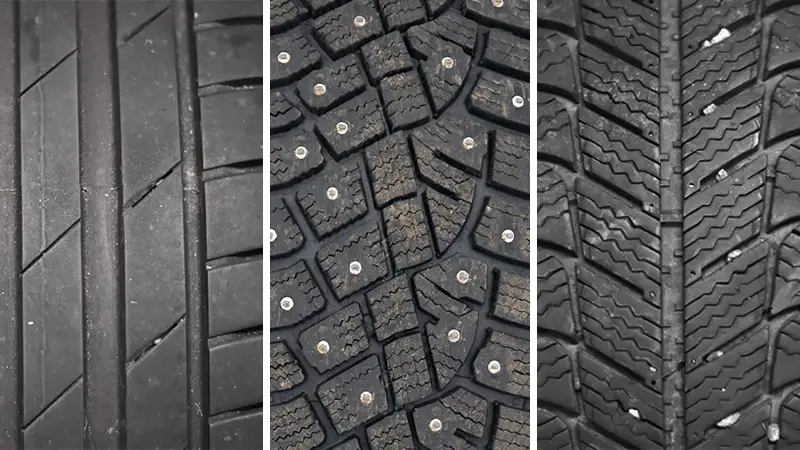Tires are the only thing connecting your vehicle to the road, so it’s important to take good care of them and keep them in the best shape possible.
While you might think that all tires are basically the same, you’d be surprised at how many different kinds there are, each designed to handle different weather conditions, driving environments, and personal preferences.
So, what’s the difference between summer, winter, and all-season tires? Summer tires are made with a hard rubber compound and a special tread pattern that allows for great grip at higher temperatures. Winter tires are made with a softer rubber compound, a special tread pattern and often with studs that help them grip well on slippery road surfaces. While all-season tires is made as a mix of both, trying to be both.
If you want to find out more about the difference between summer, winter, or all-season tires, how to tell whether a tire is summer, winter or all-season and when to use which type, keep on reading!
What Is The Difference Between Summer, Winter, And All-Season Tires?
It’s tempting to think that all tires are interchangeable. After all, aren’t they all just tires? Well, no. They aren’t. Not at all. There are many different types of tires for a variety of purposes and circumstances.
The obvious difference between summer, winter, and all-season tires are that they’re specifically made to be used during summer, winter, or as a mix of both, which is the case with all-season tires. The hardness of the rubber as well as different tread patterns is what makes the tires usable during different weather conditions.
In the image below you can see the tread pattern difference between summer, winter and all-season tires:
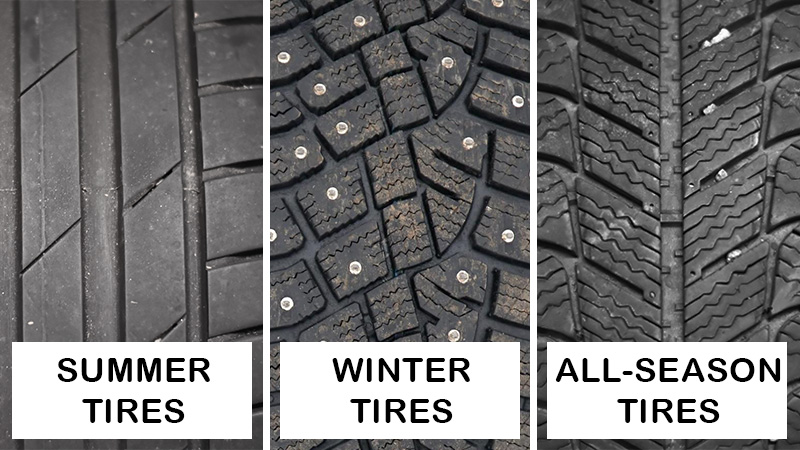
As you can see, summer tires have less aggressive tread patterns compared to both winter and all-season. Winter also has studs in this example.
We’ll look closer at each specific tire, how they’re built and how they work further down in the post.
How to Tell if Your Tires Are Summer, Winter, or All-Season?
First of all, check the treads and compare to the image above. If you notice that your tire have similar patterns as to any of the tires in the image, chances are that your tire is of that kind as well.
Secondly, you can also check the sidewall. If you see snowflake symbols and or M+S marked, it means your tires are winter tires. If you see a snowflake, an umberella and a sun mark, these are all-season tires. And if your tires lack any of these marks, then you’re dealing with summer tires.
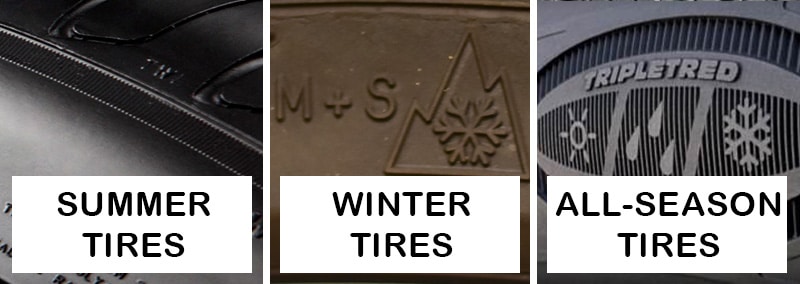
What Are Summer Tires?
In general, summer tires are made with a harder rubber compound that allows them to grip better at higher temperatures. That’s because most street driving occurs in warmer months when we need all-season or summer tires for optimal performance.
They also have more aggressive tread patterns that provide great traction on asphalt or other hard surfaces when it’s hot outside (and it’s usually pretty hot outside). If your vehicle came with these as original equipment (OEM), they’re likely called summer or performance tires.
When Are Summer Tires Needed?

Weather is a big factor in whether or not it’s time to put summer tires on your car. The changeover varies by location, but as a general rule, you’ll want to consider making your move when temperatures consistently stay above 45°F/7°C and when the raods are consistently free from snow and ice.
Additionally, tire pressure drops by 1-2 PSI when temperatures hit 60°F/16°C, meaning summer tires will have a more consistent contact patch with road surfaces. This also means that sticking with all-season tires (more about them later) at this temperature is not ideal. Even if your vehicle comes equipped with all-season tires, summer tires are a better option during warmer months.
Summer tires are designed to work at their best when temperatures are between 70°F and 75°F (21°C and 24°C).
When Are Summer Tires Supposed To Come Off?
Putting your summer tires away before winter comes around is a simple way to avoid having summer tires on in snow, slush, and generally poor road conditions.
However, many drivers find themselves unsure of exactly when to take them off. The answer is pretty simple: If you live in an area that gets any amount of snowfall or ice during winter months, you should take your summer tires off when the temperature consistently gets below 45 degrees Fahrenheit or 7 degrees Celsius outside.
How To Tell If Your Tires Are Summer Tires
The easiest way to tell if you have summer tires is to check the sidewall. If there are no “M+S” marking and no snowflake, your tires are summer tires.
Another way that you can tell is by looking at the tread pattern of your tire. A summer tire has a more streamlined tread pattern compared to a winter tire, with less grooves to clear away water and mud. A summer tire also have no studs.
What Are Winter Tires?
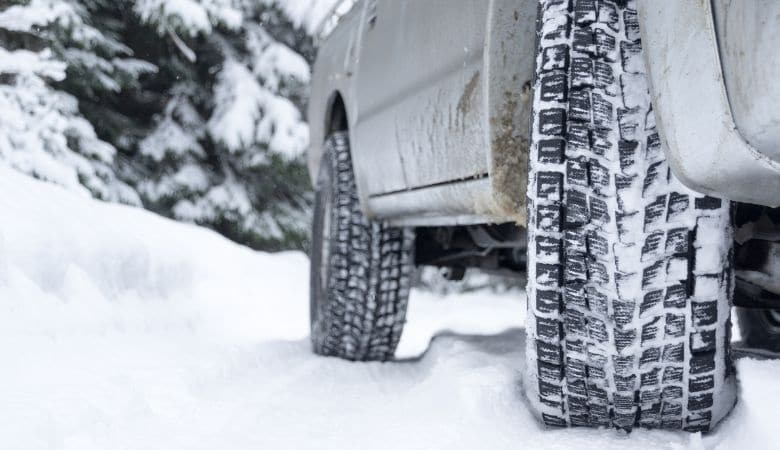
Unlike all-season or summer tires, winter tires are made with special rubber compounds and tread patterns that help them better grip slippery road surfaces. Studs are also common on winter tires.
The rubber is softer, allowing more surface area to adhere to ice and snow while also maximizing traction on dry surfaces. Winter tires have a deeper tread than all-season or summer versions.
Winter tires are also narrower. This allows them to cut through deep snow instead of floating on top of it.
In addition, because of their specially formulated tread pattern, winter tires give drivers greater control over steering in slushy snow. They’re also less susceptible of hydroplaning—that is, skidding across water-covered roads—than are nonwinter models.
There are several types of winter tires available. If you live in a snowy area, stick with studded or spiked versions for extra grip on ice and snow. For milder areas, opt for a tire that has been treated with a special material (like rubber) to increase traction in slushy conditions.
And always remember: All-season and summer tires won’t help when it comes to getting around in rough winter weather—they simply aren’t designed for it!
Why Are Winter Tires Important?
The importance of having proper tires can’t be overstated. The numbers back up these claims, too.
A 2014 Swedish study found that vehicles equipped with winter tires were 21 percent less likely to get into accidents than those with all-season or summer tires. In fact, they were 57 percent less likely than vehicles without any winter equipment on their wheels.
Winter-tire users saw a 51 percent reduction in risk as compared to summer-tire owners and an 86 percent drop in accident rates when compared to drivers who don’t use snow-rated rubber at all.
Properly maintained winter tires also provide more control over your vehicle – particularly in snowy conditions – giving you a better chance of avoiding collisions.
Even if your car isn’t rear-wheel drive, it still doesn’t mean you shouldn’t have winter tires installed! Often front-wheel-drive cars behave like they are rear-wheel drive during aggressive maneuvers like sudden stops and sharp turns.
This is where winter tires come into play, providing better traction when stopping or turning. Installing them gives you more confidence behind the wheel and peace of mind knowing that your family is safe while traveling during snowy weather conditions!

When Should Winter Tires Come Off?
A lot of people simply drive around with their winter/snow tires year-round. This is actually a really bad idea in most places, since doing so will wear down on the tires very quickly, which will significantly reduce the tires overall grip on ice, snow, and sand.
Winter tires should come off once the outdoor temperature consistently stays above 45 degrees Fahrenheit or 7 degrees Celsius and when there are no longer any snow or ice on the roads.
When it comes to using studded tires most countries have regulations where you’re only allowed to use them during certain months of the year. This is because studded tires cause a lot of damage to roads compared to non-studded tires, so state regulations are set to only allow studded tires during winter months or winter weather.
How To Tell If Your Tires Are Winter Tires
The first and easiest way to tell if your tires are appropriate for winter conditions is the tread size and whether there are any studs. Winter tires have large treads that are designed to be used in snowy and icy weather. These types of treads provide more surface area on which snow can stick, thus providing better traction. Studs help improve grip when driving on icy surfaces.
Here are quick sure ways to confirm if your tires are winter tires.
- See if they have M+S (mud and snow) or MS (mud and snow) in their name.
- Look for the 3-peak mountain/snowflake logo of AMSOIL.
- Check for code numbers on the sidewall, such as M + S, MS, or 3PMSF.
- Check tread pattern—even some all-season tires have a special tread design that offers additional traction during snowy conditions.
- Check for studs. Some winter tires come with studs that drastically improve grip on ice.
What Are All-Season Tires?
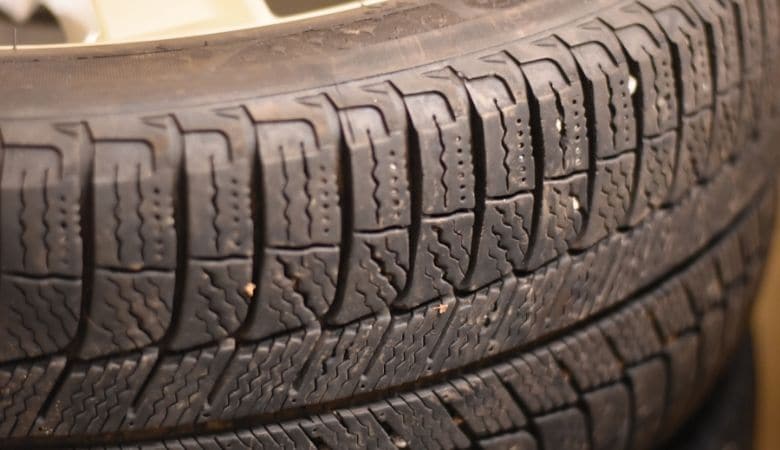
An all-season tire tries to be both a summer and winter tire – but it’s not the best at either. Meaning you won’t have quite as much grip or stability of your vehicle during snowy and slippery cinditions as you would using winter tires. And during high temperatures you won’t have the same grip as you would using summer tires.
The only time all-season tires shine are during very rough spring, summer and fall climates, like during rainy and muddy weather but when there are no snow or ice present.
Many consumers opt for special winter tires to avoid feeling unsafe when driving on ice or snow. “True” winter tires simply offer better traction and grip on snow, slush, and ice compared to all-season tires.
If you live in a place where there is no snow, and icy roads are non-existent, then you could get away with using just one set of all-season tires throughout the year.
On average, however, most people should purchase two sets of wheels: one for summertime use and another for winter weather. All-season tires tend to be slightly more expensive than their seasonal counterparts because they must do double duty year-round.
When Should All-Season Tires Be Installed?
Most consumers will only have one set of wheels on their car, so they’ll want to think long and hard before deciding between an all-season tire and a dedicated winter or summer tire. There are good arguments on both sides—and it really boils down to what kind of weather you encounter most often.
Those in northern climates (or who drive through winter conditions), for example, might see more value in driving with specialized winter tires. However, those who rarely face snowy/icy roads and mostly deal with dry pavement may find that purchasing all-season tires saves them some cash versus having to buy both summer and winter tires.
The bottom line: Consider your local climate before deciding if an all-season tire is right for you.
How To Tell If Your Tires Are All-Season
An easy way to identify all-season tires is that they will have three or four words next to all Season on the tire sidewall.
The following examples show what an all-season tire label might look like: All-Season – M+S, All-Weather, Four Seasons, Ultra Grip Ice, and Snow. If your vehicle’s owner’s manual mentions an all-weather tire with a snowflake symbol or a mountain symbol, then those are also considered All-Season Tires.
Advantages And Disadvantages Of All-Season Tires

Are all-season tires right for you? And why? All-season tires are a smart choice for many drivers who do not wish to change their tires seasonally.
While there are certain times of the year when it’s optimal to have a summer or winter tire on your vehicle, an all-season tire is a great alternative for most people. The other plus side to having all-season tires installed on your vehicle is that they will typically last much longer than a tire designed for specific seasons.
This can help save you money in terms of cost and time, as well as lessen your impact on natural resources by reducing material waste. Here are several advantages and disadvantages of all-season tires.
Advantages of All-Season Tires
Weather isn’t always ideal. If you live in a colder climate, there are times when snow, slush, or ice make driving unsafe. Drivers who have front-wheel drive vehicles have it even worse – they can get stuck on snowy roads more easily than their rear-wheel drive counterparts.
If your vehicle doesn’t have 4WD, an all-season tire is your best bet for safe driving during foul weather. They are made with rubber compounds that don’t freeze or harden when it gets cold outside, giving them great traction in both wet and dry conditions. All-season tires also feature treads with enough grooves and edges to allow for safe cornering on slick surfaces without slipping off the road altogether.
In addition, these tires tend to be quieter than summer models, which means less fatigue if you frequently commute through heavy traffic. However, one of the main benefits of buying winter tires instead of all-season ones is that they improve braking performance significantly when it’s rainy out.
Disadvantages of All-Season Tires
Despite its many advantages over other types of car gear, though, there’s one area where an all-season tire falls short: fuel economy. Experts agree that these models create more friction against the pavement and cause more rolling resistance (in turn requiring extra energy from your engine) compared to performance options with sharper tread patterns and larger lug openings.
All-season tires are ideal for drivers who want one set of wheels that can handle everything from snowy winter roads to potholes filled with rainwater. However, these “do-everything” options don’t last as long as dedicated summer or winter tires (because they’re used year round) and won’t provide quite as much traction on their less optimal surfaces.
Additionally, they tend to have a shorter tread life than their counterparts because they have to work harder. If you do opt for an all-season tire, make sure it is certified by The Rubber Manufacturers Association (RMA).
While not every brand has RMA certification, those that do will be clearly labeled. These products typically outperform non-certified models, so shop accordingly. A Consumer Reports comparison found that drivers with RMA-certified all-season tires were able to stop just 1.1 feet sooner in wet conditions compared to drivers equipped with conventional all-seasons—and 2 feet sooner in dry conditions.
Which Tire Should You Choose?
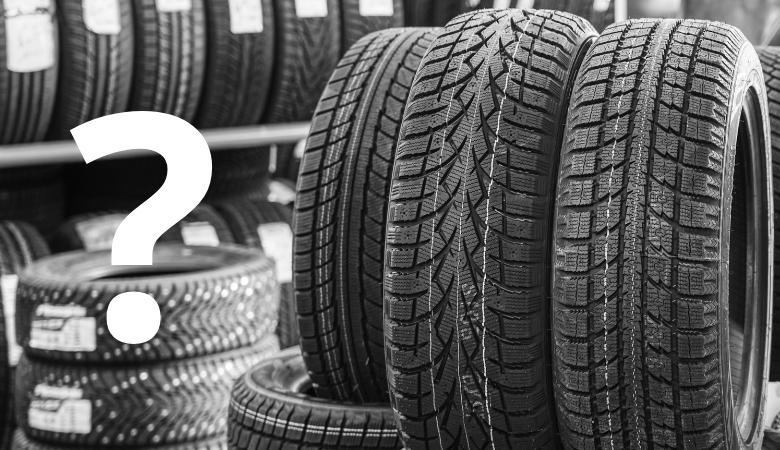
Okay, so as explained earlier, your local climate will be the main decider. If you live in a place where you get vastly different climates during summer and winter, go for a full set of summer tires and a full set of winter tires that you can change between.
If however, you live in a place where you don’t face vastly different climates, go for summer tires if you have summer climate all year, winter tires if you have winter climate all year, and all-season tires if you face occasional snowy, slippery and wet climates throughout the year.
This way, you can choose a tire designed for your climate without breaking the bank, as you would by purchasing multiple set of different tires when you really don’t need to.
Conclusion
It doesn’t matter what season it is in your area of the country; tires are a necessary accessory that not only makes driving safer but can even improve your gas mileage.
While choosing your tires might seem like an easy choice for those that simply just need one or two sets for their cars and trucks, there are actually a lot of things to consider when making such a decision.
We hope that you now have a better understanding of how to choose the right set of tires, whether they be summer, winter, or all-season. Next time you need to purchase new tires, make sure you ask yourself these questions to ensure you are making an informed decision!
Hi, my name is Niklas, the head content creator & CEO of Whirling Wheelz. I am very interested in vehicles of all kinds, mainly cars. I have a car mechanics degree from high school and a big hobby of mine is to follow the WRC (World Rally Championship) both online and through travel.

